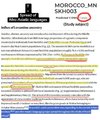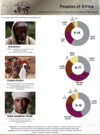As we progress through more genetic evidence and data, layers of connections between Haplogroup T (specifically downstream of T-L208) and the spread of Afro-Asiatic culture/languages reveal themselves. Once dismissed as a minor lineage, haplogroup T is emerging as a foundational Afro-Asiatic Neolithic genetic signature, deeply embedded in the fabric of Saharan pastoralism, Nile Valley societies and roots of the overall early Afro-Asiatic world. It's time to recognize this overlooked legacy as it's true role, one of the original messengers between Africa and Eurasia, and possibly one of the original back-to-Africa Neolithic migrations. The absolute earliest origins of Haplogroup T starts with it's ancestor - K who split → LT →L & T . Haplogroup L, sibling of T, spread east and populated Dravidian/Indus Valley civillizations, where it is seen in frequencies of over 1/3rd. This places the likely location of ancestor "LT" in the broad Kashmir areas of modern Pakistan and alike. Unlike it's sibling, T travelled opposite direction-west and found itself in the Levant very early on where we see a Levant PPNB man in Jordan, Ain Ghazal (sample i1707) bordering Asia and Africa almost 10,000 years ago (7,500-7,770 BCE). The Ain Ghazal man was full PPNB ancestry wise, Natufian Hunter Gatherer+Anatolian Neolithic farmer descent, no trace of Zagrosian Iranian/ Caucasian DNA yet. This is significant because it represents not just the oldest T sample ever found in the world, but also the FIRST Levant PPNB sample in general ever found in the world - before the arrival of haplogroups like J and overall Caucaso-Mesopotamian influx, by over a thousand years.
This places T in the Neolithic Levant setting it's known evolutionary checkpoint. Where haplogroup E was the native of the Levant, T lived alongside and formed it's own communities. Later samples of Chalcolithic Levantines of Peqi'in prove that indeed ancients similar to the i1707 of Ain Ghazal settled across the entire Levant and had communities. PubMed National Library of Medicine has stated their findings in their analysis of Chalcolithic Levant and stated, "...most of the male individuals (nine out of ten) belong to the Y-chromosome haplogroup T...This finding contrasts with both earlier (Neolithic and Epipaleolithic) Levantine populations, which were dominated by haplogroup E, and later Bronze Age individuals, all of whom belonged to haplogroup J". Early findings like this have and the wide dispersal of T after has caused a narrative that T-M70 is the original Israelite lineage if there was one, published books such as "Traced" (2022) by Nathaniel Jeanson expand more on this claim, though this is not the topic of my discussion today. It is pretty well agreed upon that T-M70 was likely the first Eurasian paternal haplogroup to have arrived and settled in the Levant-at least paternally by the father, unlike haplogroups like G (associated with Anatolian Farmers) who's genetic signature was spread mostly maternally. The Peqi'in samples also have been observed to share the same beliefs as early Sumerians praying to the same deities and similar customs. This is where the Sumerian-T connection holds ground and earlier (pre-back-to-Africa) haplogroup T clades were spread where we find many Middle Easterners, Assyrians, Iranians, even Indians under pre-T-L208 (keep in mind only 10% of modern T men are not T-L208) clades and a couple who went into Europe and took a EEF route where we find ancient samples like the Golden Man - Varna King (sample ANI152/VAR043), the elite man of the local community who was buried amongst I & R haplogroups, the fact that he was mostly of ANF ancestry autosomal (and some WHG) tells us this European clade of T had competitive routes with G and I, and was of different origin but ultimately also absorbed by mostly Neolithic Anatolian (ANF) ancestry, once again, maternally. The Varna King was found ~4,500 BCE, roughly 2,000 years after Ain Ghazal PPNB. The EEF and Varna King lineages are ALSO a different/separate from the Saharan Pastoralist lineage who is the subject of this discussion which is thousands of years older, but helps us understand more of T's structure. So going back to topic, from Levant, T travels south finally. This migration is documented, though he reason is heavily disputed and some relate it to ancient droughts of the Levant/Fertile crescent, whilst simultaneously the Sahara was still green and thriving, prompting this relocation. From the Levant. T haplogroup holders moved in through the Sinai, by land, to the Nile Valley, into the central Sahara and south to Sudan. These Saharan descendants are the Chadians (mostly Toubou & Daza), Fulani (mostly Wodaabe), Nubians of Sudan (Kulubnarti), Ancient Egyptians (Mummy sample 2516), Ancient Berbers, and Djiboutians (BEFORE the popular Somali/Horner clade entrance via Bab El Mandab, Yemen, which is under T-Y16897). Haplogroup R1b-V88 shows high frequency in the same populations where T-L208 is seen. It its thought that the Saharan entrance of T paralleled or was similar to the same time R1b-V88 entered Africa which was 7,700 ± 1,600 years ago, where we know T-L208 was definitely in Levant bordering Africa at that same exact time. Today, T-L208 and R1b-V88 are the only two surviving descendants of K in Africa.One of the most revealing studies of African evolution during the Humid Era by PubMed National Library of Medicine has deemed that Saharan Pastoralism was introduced into Sinai from the Levant, and they were haplogroup T and have labeled these newcomers with eastern origin as "Saharan Pastoralists", a distinct lineage who brought cattle, pottery traditions, and natural resources like obsidian into the Sahara. The subjects of the study are Northwest African local samples "SKH002" and "SKH003", who were the newly "formed" people with different ancestry once again compared to older Iberomaursian "E" holders, and the Anatolian Neolithic "G" holders. The SKH002 and SKH003 samples were a two-way split between local Iberomaursian-like ancestry and Levant PPNB ancestry. Guess what haplogroup SKH002 and SKH003 were under? They were Haplogroup T. Under the same clade that Chadian's and Fulanis share (T-Y6671). The article states, "Furthermore, in the Middle Neolithic a new ancestry with an eastern origin is detected in northwestern Africa. This ancestry indicates new migrating groups, potentially associated with Sahara pastoralists, which admixed with local groups". The findings stress that these Levantines had their own unique migrations and indeed became Saharan Pastoralists combining the earliest foundations of future Afro Asiatic culture. These haplogroup T members did not have EEF/ Anatolian Neolithic Farmer ancestry associated with Early European expansion, unlike some other samples of Northern Moroccans who clearly had continuity with Span/Gibraltar- no- T was different. The artice by PubMed National Library of Medcicine once again states "this Neolithic Levantine ancestry has not been observed on the European side of the Mediterranean during the Neolithic, it probably represents an independent expansion of people from the Levant into North Africa. Migrations from the Levant to eastern Africa have been identified for Neolithic pastoralist individuals around 4,000 years ago, who are presumed descendants of unsampled northeastern African populations associated with the spread of Saharan pastoralism". In fact when models included a Europeann component, the model would outright fail. "The ancestry in SKH can be modelled as a two-way admixture between Levant Neolithic populations (roughly 76.4 ± 4.0%) and local northwestern Africans (represented by TAF; 23.6 ± 4.0%). If a European Neolithic (for example, from Iberia) additional source population is added, the model is rejected."

The name that should be used when referring to oursleves (African descendants of T-L208) is Saharan Pastoralists. Many descendants of these Saharan lineages are no longer even in Africa, because multiple T clades who traveled back-to-Africa as T Pastoralists, once again left after to join other Near-Eastern and European civilizations like in Rome, Arabia, and even as far up to the British Isles. You must remember, most were still living in lands controlled by Near-eastern and european cultures, so much of T rejoined them. T-CTS11451 can be seen as the "Sinai" mutation.
Haplogroup T are south-central asian hunter gatherers from LT/K who became skilled sivillization builders early on, expanding into the whole Middle East with agriculture, eventually travelling south where they transformed into Saharan Pastoralists and were a foundation of Afro-Asiatic culture. Simply, the Afro-Asiatic world would not be as prominent without Haplogroup T.
This places T in the Neolithic Levant setting it's known evolutionary checkpoint. Where haplogroup E was the native of the Levant, T lived alongside and formed it's own communities. Later samples of Chalcolithic Levantines of Peqi'in prove that indeed ancients similar to the i1707 of Ain Ghazal settled across the entire Levant and had communities. PubMed National Library of Medicine has stated their findings in their analysis of Chalcolithic Levant and stated, "...most of the male individuals (nine out of ten) belong to the Y-chromosome haplogroup T...This finding contrasts with both earlier (Neolithic and Epipaleolithic) Levantine populations, which were dominated by haplogroup E, and later Bronze Age individuals, all of whom belonged to haplogroup J". Early findings like this have and the wide dispersal of T after has caused a narrative that T-M70 is the original Israelite lineage if there was one, published books such as "Traced" (2022) by Nathaniel Jeanson expand more on this claim, though this is not the topic of my discussion today. It is pretty well agreed upon that T-M70 was likely the first Eurasian paternal haplogroup to have arrived and settled in the Levant-at least paternally by the father, unlike haplogroups like G (associated with Anatolian Farmers) who's genetic signature was spread mostly maternally. The Peqi'in samples also have been observed to share the same beliefs as early Sumerians praying to the same deities and similar customs. This is where the Sumerian-T connection holds ground and earlier (pre-back-to-Africa) haplogroup T clades were spread where we find many Middle Easterners, Assyrians, Iranians, even Indians under pre-T-L208 (keep in mind only 10% of modern T men are not T-L208) clades and a couple who went into Europe and took a EEF route where we find ancient samples like the Golden Man - Varna King (sample ANI152/VAR043), the elite man of the local community who was buried amongst I & R haplogroups, the fact that he was mostly of ANF ancestry autosomal (and some WHG) tells us this European clade of T had competitive routes with G and I, and was of different origin but ultimately also absorbed by mostly Neolithic Anatolian (ANF) ancestry, once again, maternally. The Varna King was found ~4,500 BCE, roughly 2,000 years after Ain Ghazal PPNB. The EEF and Varna King lineages are ALSO a different/separate from the Saharan Pastoralist lineage who is the subject of this discussion which is thousands of years older, but helps us understand more of T's structure. So going back to topic, from Levant, T travels south finally. This migration is documented, though he reason is heavily disputed and some relate it to ancient droughts of the Levant/Fertile crescent, whilst simultaneously the Sahara was still green and thriving, prompting this relocation. From the Levant. T haplogroup holders moved in through the Sinai, by land, to the Nile Valley, into the central Sahara and south to Sudan. These Saharan descendants are the Chadians (mostly Toubou & Daza), Fulani (mostly Wodaabe), Nubians of Sudan (Kulubnarti), Ancient Egyptians (Mummy sample 2516), Ancient Berbers, and Djiboutians (BEFORE the popular Somali/Horner clade entrance via Bab El Mandab, Yemen, which is under T-Y16897). Haplogroup R1b-V88 shows high frequency in the same populations where T-L208 is seen. It its thought that the Saharan entrance of T paralleled or was similar to the same time R1b-V88 entered Africa which was 7,700 ± 1,600 years ago, where we know T-L208 was definitely in Levant bordering Africa at that same exact time. Today, T-L208 and R1b-V88 are the only two surviving descendants of K in Africa.One of the most revealing studies of African evolution during the Humid Era by PubMed National Library of Medicine has deemed that Saharan Pastoralism was introduced into Sinai from the Levant, and they were haplogroup T and have labeled these newcomers with eastern origin as "Saharan Pastoralists", a distinct lineage who brought cattle, pottery traditions, and natural resources like obsidian into the Sahara. The subjects of the study are Northwest African local samples "SKH002" and "SKH003", who were the newly "formed" people with different ancestry once again compared to older Iberomaursian "E" holders, and the Anatolian Neolithic "G" holders. The SKH002 and SKH003 samples were a two-way split between local Iberomaursian-like ancestry and Levant PPNB ancestry. Guess what haplogroup SKH002 and SKH003 were under? They were Haplogroup T. Under the same clade that Chadian's and Fulanis share (T-Y6671). The article states, "Furthermore, in the Middle Neolithic a new ancestry with an eastern origin is detected in northwestern Africa. This ancestry indicates new migrating groups, potentially associated with Sahara pastoralists, which admixed with local groups". The findings stress that these Levantines had their own unique migrations and indeed became Saharan Pastoralists combining the earliest foundations of future Afro Asiatic culture. These haplogroup T members did not have EEF/ Anatolian Neolithic Farmer ancestry associated with Early European expansion, unlike some other samples of Northern Moroccans who clearly had continuity with Span/Gibraltar- no- T was different. The artice by PubMed National Library of Medcicine once again states "this Neolithic Levantine ancestry has not been observed on the European side of the Mediterranean during the Neolithic, it probably represents an independent expansion of people from the Levant into North Africa. Migrations from the Levant to eastern Africa have been identified for Neolithic pastoralist individuals around 4,000 years ago, who are presumed descendants of unsampled northeastern African populations associated with the spread of Saharan pastoralism". In fact when models included a Europeann component, the model would outright fail. "The ancestry in SKH can be modelled as a two-way admixture between Levant Neolithic populations (roughly 76.4 ± 4.0%) and local northwestern Africans (represented by TAF; 23.6 ± 4.0%). If a European Neolithic (for example, from Iberia) additional source population is added, the model is rejected."
The name that should be used when referring to oursleves (African descendants of T-L208) is Saharan Pastoralists. Many descendants of these Saharan lineages are no longer even in Africa, because multiple T clades who traveled back-to-Africa as T Pastoralists, once again left after to join other Near-Eastern and European civilizations like in Rome, Arabia, and even as far up to the British Isles. You must remember, most were still living in lands controlled by Near-eastern and european cultures, so much of T rejoined them. T-CTS11451 can be seen as the "Sinai" mutation.
Haplogroup T are south-central asian hunter gatherers from LT/K who became skilled sivillization builders early on, expanding into the whole Middle East with agriculture, eventually travelling south where they transformed into Saharan Pastoralists and were a foundation of Afro-Asiatic culture. Simply, the Afro-Asiatic world would not be as prominent without Haplogroup T.



